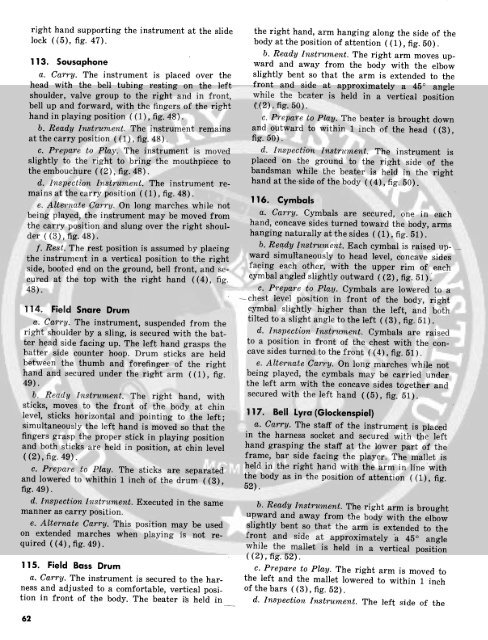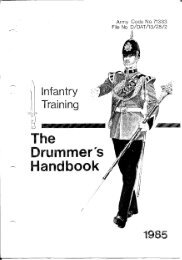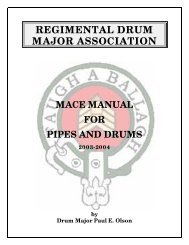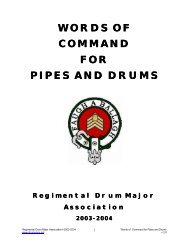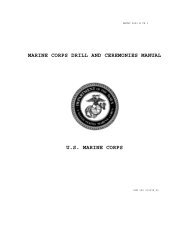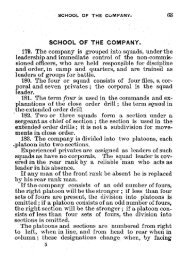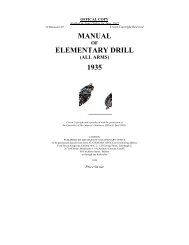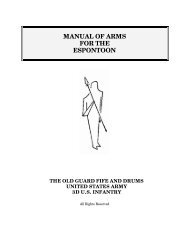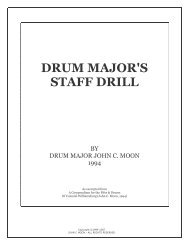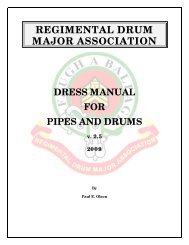The Military Band - Regimental Drum Major Association
The Military Band - Regimental Drum Major Association
The Military Band - Regimental Drum Major Association
Create successful ePaper yourself
Turn your PDF publications into a flip-book with our unique Google optimized e-Paper software.
ight hand supporting the instrument at the slide the right hand, arm hanging along the side of the<br />
lock ((5), fig. 47). body at the position of attention ( (1), fig. 50).<br />
b. Ready Instrument. <strong>The</strong> right arm moves up-<br />
113. Sousaphone ward and away from the body with the elbow<br />
a. Carry. <strong>The</strong> instrument is placed over the slightly bent so that the arm is extended to the<br />
head with the bell tubing resting on the left front and side at approximately a 45 ° angle<br />
shoulder, valve group to the right and in front, while the beater is held in a vertical position<br />
bell up and forward, with the fingers of the right ((2), fig. 50).<br />
hand in playing position ((1), fig. 48). c. Prepare to Play. <strong>The</strong> beater is brought down<br />
b. Ready Instrument. <strong>The</strong> instrument remains and outward to within 1 inch of the head ((3),<br />
at the carry position ((1), fig. 48). fig. 50).<br />
c. Prepare to Play. <strong>The</strong> instrument is moved d. Inspection Instrument. <strong>The</strong> instrument is<br />
slightly to the right to bring the mouthpiece to placed on the ground to the right side of the<br />
the embouchure ((2), fig. 48). bandsman while the beater is held in the right<br />
d. Inspection Instrument. <strong>The</strong> instrument re- hand at the side of the body ((4), fig. 50).<br />
mains at the carry position ((1), fig. 48).<br />
e. Alternate Carry. On long marches while not 116. Cymbals<br />
being played, the instrument may be moved from a. Carry. Cymbals are secured, one in each<br />
the carry position and slung over the right shoul- hand, concave sides turned toward the body, arms<br />
der ( (3), fig. 48). hanging naturally at the sides ( (1), fig. 51).<br />
f. Rest. <strong>The</strong> rest position is assumed by placing b. Ready Instrument. Each cymbal is raised upthe<br />
instrument in a vertical position to the right ward simultaneously to head level, concave sides<br />
side, booted end on the ground, bell front, and se- facing each other, with the upper rim of each<br />
cured at the top with the right hand ((4), fig. cymbal angled slightly outward ((2),fig. 51).<br />
48). c. Prepare to Play. Cymbals are lowered to a<br />
-chest level position in front of the body, right<br />
114. Field Snare <strong>Drum</strong> cymbal slightly higher than the left, and both<br />
a. Carry. <strong>The</strong> instrument, suspended from the tilted to a slight angle to the left ((3), fig. 51).<br />
right shoulder by a sling, is secured with the bat- d. Inspection Instrument. Cymbals are raised<br />
ter head side facing up. <strong>The</strong> left hand grasps the to a position in front of the chest with the conbatter<br />
side counter hoop. <strong>Drum</strong> sticks are held cave sides turned to the front ((4), fig. 51).<br />
between the thumb and forefinger of the right e. Alternate Carry. On long marches while not<br />
hand and secured under the right arm ((1), fig. being played, the cymbals may be carried under<br />
49). the left arm with the concave sides together and<br />
b. Ready Instrument. <strong>The</strong> right hand, with secured with the left hand ((5), fig. 51).<br />
sticks, moves to the front of the body at chin<br />
level, sticks horizontal and pointing to the left; 117. Bell Lyr(Glockenspiel)<br />
simultaneously the left hand is moved so that the a. Carry. <strong>The</strong> staff of the instrument is placed<br />
fingers grasp the proper stick in playing position in the harness socket and secured with the left<br />
and both sticks are held in position, at chin level hand grasping the staff at the lower part of the<br />
((2),fig. 49). frame, bar side facing the player. <strong>The</strong> mallet is<br />
c. Prepare to Play. <strong>The</strong> sticks are separated held in the right hand with the arm in line with<br />
and lowered to whithin 1 inch of the drum ((3), the body as in the position of attention ((1), fig.<br />
fig. 49). 52).<br />
d. Inspection Instrument. Executed in the same b. Ready Instrument. <strong>The</strong> right arm is brought<br />
manner as carry position. upward and away from the body with the elbow<br />
e. Alternate Carry. This position may be used slightly bent so that the arm is extended to the<br />
on extended marches when playing is not re- front and side at approximately a 45 ° angle<br />
quired ((4), fig. 49). while the mallet is held in a vertical position<br />
((2), fig. 52).<br />
115. Field Bass <strong>Drum</strong> c. Prepare to Play. <strong>The</strong> right arm is moved to<br />
a. Carry. <strong>The</strong> instrument is secured to the har- the left and the mallet lowered to within 1 inch<br />
ness and adjusted to a comfortable, vertical posi- of the bars ((3), fig. 52).<br />
tion in front of the body. <strong>The</strong> beater is held in d. Inspection Instrument. <strong>The</strong> left side of the<br />
62


